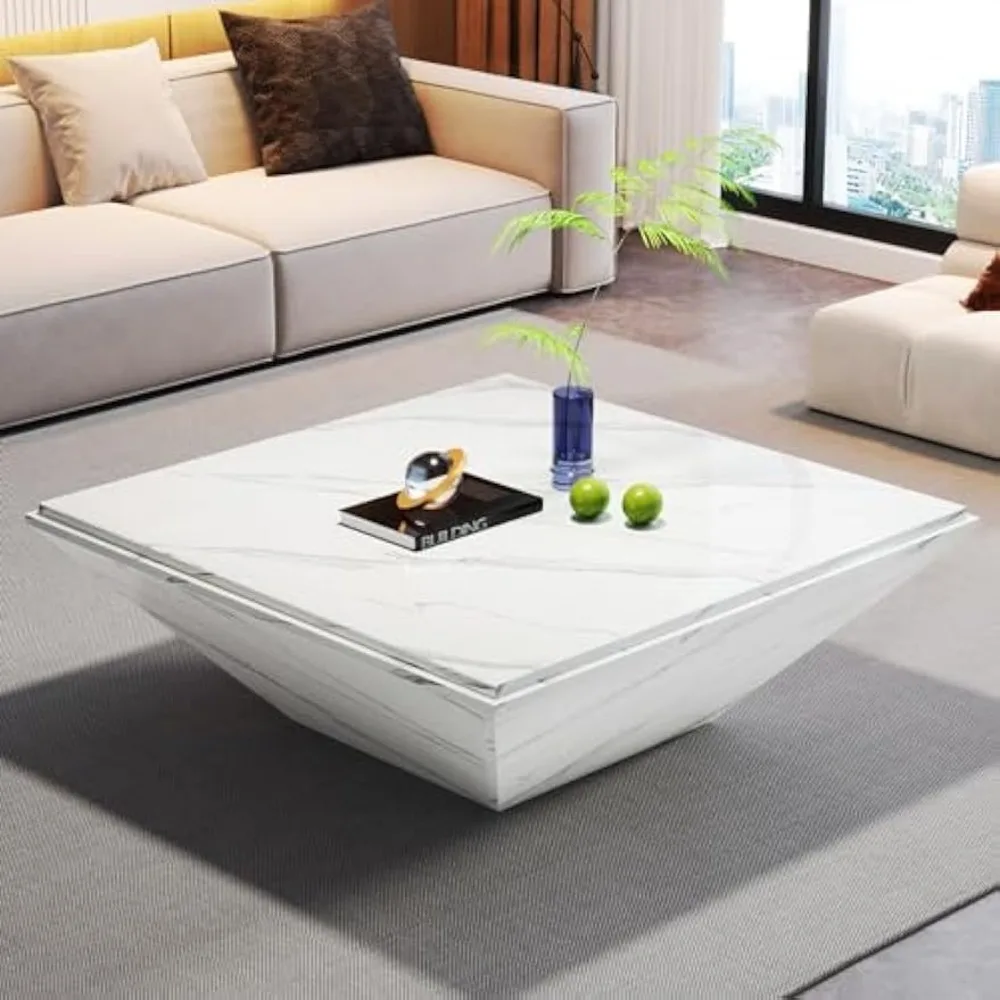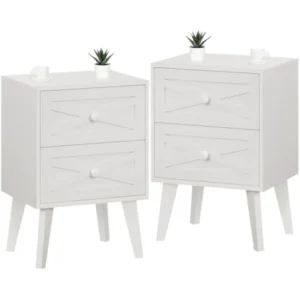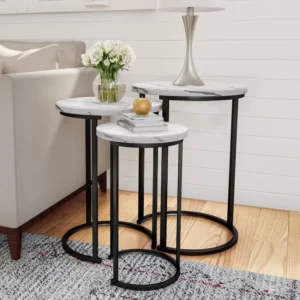Why a Square Coffee Table Works Perfectly in Your Living Space
Square coffee tables offer a unique appeal in home design that other shapes simply can’t match. With their perfectly balanced proportions, these tables create immediate visual harmony in any living area. Unlike their round or rectangular counterparts, square tables provide equal sides that establish a sense of order and symmetry, making them incredibly versatile for various seating arrangements.
The benefits of choosing a square coffee table include:
- Perfect symmetry that creates a natural focal point in your living room
- Versatility that works equally well with traditional and contemporary furniture styles
- Space-efficient design that maximizes surface area without awkward protrusions
- Equal access from all sides, making them ideal for conversation areas
A square table’s geometric precision makes it particularly effective in rooms where you want to establish clear visual boundaries. Many design professionals appreciate how intelligent black mid-century coffee tables can anchor a seating area while providing practical functionality.
Square coffee tables also excel in rooms where space efficiency matters. Their clean lines and predictable footprint make them easier to navigate around compared to rectangular tables that might extend too far into walkways or round tables that can waste valuable floor space.
Exploring different mid-century modern square coffee tables reveals how this shape has remained popular through decades of evolving design trends, proving their enduring appeal in home interiors.
Essential Principles for Arranging Seating Around Your Square Coffee Table
Creating the perfect seating arrangement around your square coffee table isn’t just about aesthetics—it’s about creating a functional, comfortable space that enhances your daily life. The key is finding the sweet spot between visual appeal and practical usability.
When working with a square coffee table, you’ll want to consider both symmetry and access. Unlike oval or rectangular tables that naturally direct traffic flow, square tables create equal opportunity for seating on all sides. This unique characteristic requires thoughtful planning to maximize their potential.
Balance is particularly important with square tables. Their geometric precision calls for arrangements that complement rather than compete with this strong shape. Many homeowners discover that styling black mid-century coffee tables can transform an ordinary living room into a sophisticated gathering space when the surrounding seating is properly positioned.
The following principles will guide you through creating seating arrangements that not only look professional but function beautifully for everyday living and entertaining.
Perfect Proportions: Sizing Your Coffee Table to Your Seating
Getting the size relationship right between your coffee table and seating is fundamental to a successful arrangement. A table that’s too large overwhelms the space, while one that’s too small creates awkward reaching distances and appears insignificant.
For optimal balance:
– Your square coffee table should be approximately two-thirds the length of your sofa
– The table height should sit 1-2 inches (2.5-5 cm) lower than your seating cushions
– For standard 84-inch (213 cm) sofas, a 36-40 inch (91-102 cm) square table works well
– Smaller loveseats pair best with 30-36 inch (76-91 cm) square tables
The square shape affects these proportions differently than rectangular or round tables. Because a square extends equally in all directions, it needs more clearance around it to avoid feeling crowded. This makes finding ideal square coffee table dimensions particularly important for your specific room layout.
For smaller rooms, consider nesting tables or tables with rounded corners to maintain proper proportions while improving flow around the seating area.
Mastering Clearance and Flow: Creating Comfortable Access
Proper clearance around your coffee table ensures everyone can move comfortably and access both the table and seating with ease. These measurements make the difference between a welcoming space and one that feels awkward or cramped.
| Room Size | Coffee Table to Seating | Walkway Clearance | Total Area Needed |
|---|---|---|---|
| Small | 14-16 inches (35-40 cm) | 30 inches (76 cm) | 10×10 ft (3×3 m) |
| Medium | 16-18 inches (40-45 cm) | 32 inches (81 cm) | 12×12 ft (3.6×3.6 m) |
| Large | 18 inches (45 cm) | 36 inches (91 cm) | 14×14 ft (4.3×4.3 m) |
Square coffee tables present unique clearance considerations. Their corners can protrude into walkways more than round tables, so pay special attention to traffic patterns. Position the table so its corners don’t align directly with natural walking paths.
For optimal movement, ensure each side of your table has equal clearance from seating to maintain the balanced feel that makes square tables so appealing. Browsing various mid-century modern coffee tables can help you visualize how different sizes might work in your space before making a final decision.
Creating Conversation-Friendly Arrangements
A well-designed seating arrangement naturally facilitates conversation, bringing people together in comfortable interaction. Square coffee tables excel as conversation anchors because they provide equal access to everyone seated around them.
For the best conversation flow:
– Position seating no more than 8 feet (2.4 m) apart for easy conversation without raising voices
– Arrange seats so people face each other at comfortable angles, typically between 45-90 degrees
– Ensure everyone has a clear view of other seated guests without awkward turning
– Create multiple “conversation zones” for larger gatherings by using the table’s corners as natural dividers
The square shape naturally creates a democratic conversation space where no seat feels superior or isolated. This makes square coffee tables particularly effective for family rooms and spaces meant for regular social interaction.
The Square Table as Your Room’s Focal Point
A square coffee table has unique power to anchor your living space and create a strong focal point around which all other elements revolve. Its geometric precision naturally draws the eye and provides balance to the room’s composition.
When positioning your square table as a focal point, consider how its lines relate to other strong elements in the room. The perpendicular edges create visual pathways that lead the eye around the space, particularly when aligned with architectural features like fireplaces or large windows.
The table’s symmetry also allows it to hold more substantial decorative elements without appearing unbalanced. Many interior designers find that decorating black mid-century coffee tables with carefully chosen objects reinforces their status as the room’s centerpiece while expressing personal style.
Popular Seating Configurations with Square Coffee Tables
The versatility of square coffee tables allows for numerous effective seating arrangements. Depending on your room’s dimensions, traffic patterns, and how you use the space, certain configurations will work better than others. Each arrangement capitalizes on the square table’s equal sides while addressing different living needs.
These configurations range from casual, everyday setups to more formal arrangements for entertaining. Some work better for intimate conversations, while others excel at accommodating larger groups. The following sections explore the most functional and visually appealing options to help you find the perfect arrangement for your home.
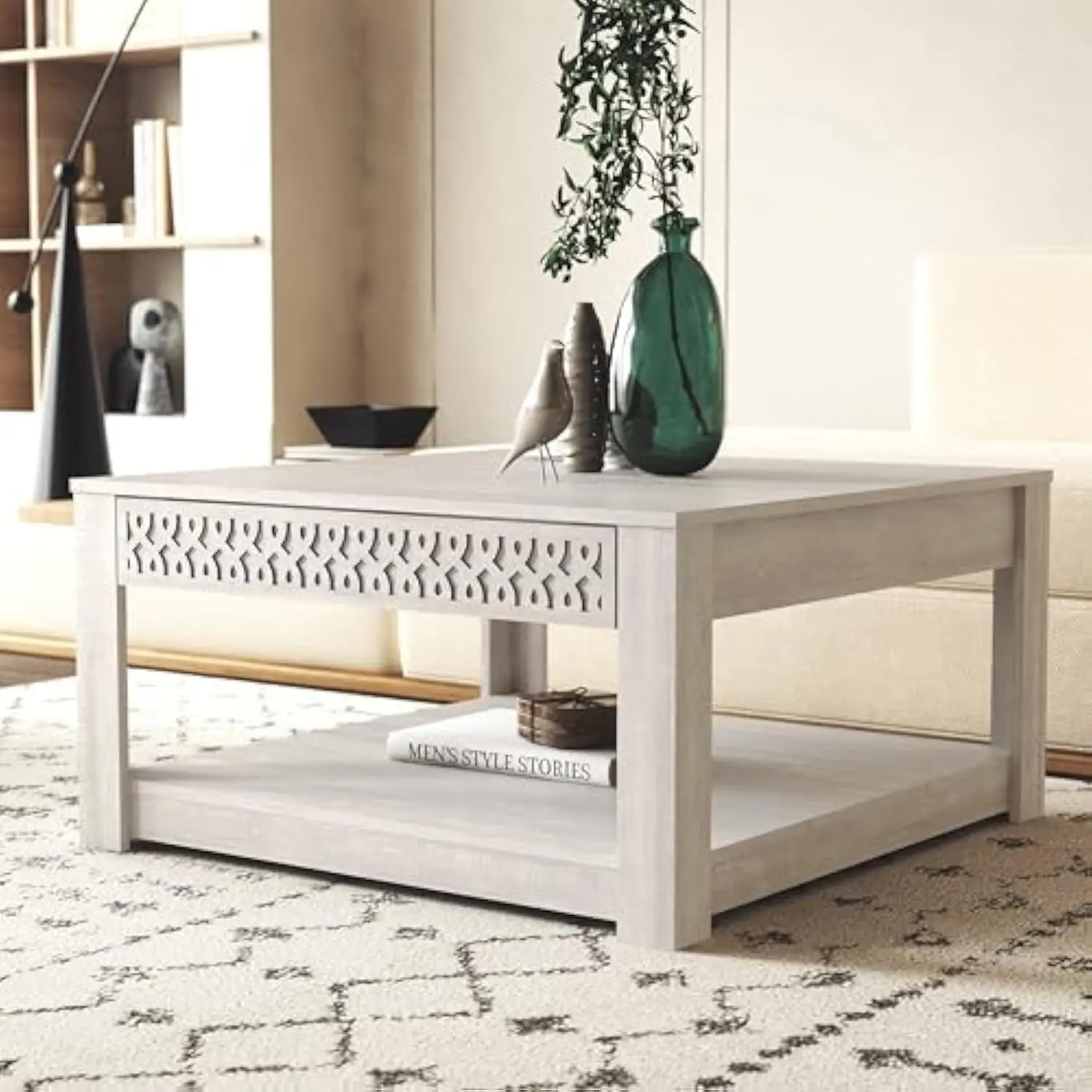
The L-Shaped Sectional: Creating Balance with Corners
L-shaped sectionals and square coffee tables make natural partners. The clean, geometric lines of both pieces complement each other perfectly, creating a cohesive and inviting seating area.
For optimal positioning with sectionals:
– Center the table within the inner corner of the “L,” leaving 14-18 inches (35-45 cm) between the table and seating
– Position the table slightly closer to the corner junction rather than perfectly centered for better accessibility
– If the sectional is large, consider a larger square table (40-48 inches/102-122 cm) to maintain proportion
– Add a single armchair opposite the sectional to complete the conversation area when needed
The table’s corners naturally align with the sectional’s shape, creating clear pathways for entry and exit. This arrangement particularly benefits from mid-century modern lift-top coffee tables, which provide additional functionality without disrupting the clean lines of this configuration.
The U-Shaped Arrangement: Embracing with Seating
For more formal living rooms or spaces designed primarily for entertaining, a U-shaped seating arrangement creates an intimate conversation area that fully showcases your square coffee table.
This configuration involves placing a sofa as the base of the “U” with loveseats or pairs of chairs forming the sides, all surrounding your square coffee table. The table serves as the perfect centerpiece, equally accessible to everyone seated.
For this arrangement to work effectively:
– Position all seating approximately 16-18 inches (40-45 cm) from the table edges
– Create at least one 30-inch (76 cm) entry/exit point to the arrangement
– Ensure the overall scale suits your room—this configuration requires more space than others
– Use identical side chairs for a formal look or mix complementary styles for a more eclectic approach
This arrangement excels for dinner parties, game nights, or situations where multiple people gather for extended conversation, making it a favorite for homes that frequently entertain guests.
Facing Sofas: Classic Symmetry
The facing sofa arrangement offers timeless elegance that perfectly complements the symmetrical nature of a square coffee table. Two sofas of equal length positioned directly across from each other with the table centered between them creates a powerful visual statement.
For this classic configuration:
– Keep both sofas equidistant from the table, typically 16-18 inches (40-45 cm)
– Ensure at least 6-7 feet (1.8-2.1 m) between sofas for comfortable passage while maintaining conversation distance
– Consider adding end tables at either end to complete the arrangement
– For variety, use one sofa and two matching chairs on the opposite side
This arrangement works beautifully in formal living rooms and spaces where symmetry is a priority. The equal sides of your square coffee table reinforce this balance, creating a harmonious and sophisticated seating area. Large coffee tables with strong design elements particularly shine in this configuration, becoming true statement pieces.
Sofa and Armchair Combinations: Flexibility with Balance
This versatile arrangement pairs a standard sofa with one or two complementary armchairs to create a balanced, adaptable seating group that works in most homes.
For effective sofa and armchair combinations:
– Position the sofa on one side of the square coffee table
– Place chairs at right angles to the sofa or at a comfortable 45-degree angle
– For two chairs, either place them side by side opposite the sofa or split them to different sides
– Keep all seating pieces 14-18 inches (35-45 cm) from the table edges
The advantage of this arrangement is its flexibility—chairs can be easily repositioned for different social situations or room layouts. Incorporating coordinating mid-century modern square side end tables between chairs or at the sofa ends completes the look while adding functional surface space.
The Armchair Quartet: Intimate Conversation Circles
For rooms without a sofa or spaces dedicated to intimate conversation, four armchairs arranged around a square coffee table creates a perfectly balanced seating area ideal for reading nooks, libraries, or secondary living spaces.
This democratic arrangement gives every seat equal importance and access to the table. To execute it successfully:
– Position chairs at each side of the square table, facing the center
– Maintain equal 14-16 inch (35-40 cm) clearance between each chair and the table
– Choose a room location that allows at least 30 inches (76 cm) of clearance behind each chair
– Consider swivel armchairs to facilitate both conversation and movement
This arrangement works best in rooms of at least 10×10 feet (3×3 meters) and with chairs that are proportional to the table—oversized chairs may crowd the space, while chairs that are too small can make the table appear disproportionately large.
Modular Flexibility: Adapting to Changing Needs
Today’s modular furniture systems pair wonderfully with square coffee tables, allowing you to reconfigure your seating arrangement based on changing needs while maintaining the table as your anchor point.
The geometric precision of a square table provides a constant reference point as you adjust your modular pieces. As you shift sections to accommodate different activities or group sizes, keep these principles in mind:
– Maintain consistent clearance (14-18 inches/35-45 cm) between the table and seating
– Ensure at least one clear access point to the arrangement
– When rearranging sections, position the table first as your center point
– Consider how traffic flow changes with each new configuration
This adaptable approach suits contemporary lifestyles where spaces often serve multiple purposes. Many homeowners find inspiration in black mid-century coffee table design when creating modular arrangements that blend functionality with distinctive style.
Solutions for Common Design Challenges
Even with the best design intentions, real-world spaces often present obstacles that complicate furniture arrangement. From tiny apartments to awkward architectural features, these challenges require creative solutions. The following sections address the most common issues people face when arranging seating around square coffee tables, providing practical workarounds that maintain both style and function.
Mid-Century Modern End Table Sets of 2, Mid-Century Modern Square Side & End Tables, Mid-Century Modern White Side & End Tables
$348.24 Select options This product has multiple variants. The options may be chosen on the product pageMid-Century Modern Solid Wood Coffee Tables, Mid-Century Modern Teak Coffee Tables
$879.95 Select options This product has multiple variants. The options may be chosen on the product pageMid-Century Modern Danish Coffee Tables, Mid-Century Modern Oval Coffee Tables, Mid-Century Modern Solid Wood Coffee Tables
$390.05 Select options This product has multiple variants. The options may be chosen on the product pageMid-Century Modern Nesting Side & End Tables, Mid-Century Modern Nesting Table Sets, Mid-Century Modern Round Side & End Tables
Price range: $239.35 through $273.06 Select options This product has multiple variants. The options may be chosen on the product pageMid-Century Modern Coffee & End Table Sets, Mid-Century Modern Coffee Table Sets, Mid-Century Modern Oval Coffee Tables
Price range: $257.48 through $331.04 Select options This product has multiple variants. The options may be chosen on the product pageMid-Century Modern Glass Top Coffee Tables, Mid-Century Modern Glass Top Side & End Tables
$460.58 Select options This product has multiple variants. The options may be chosen on the product page
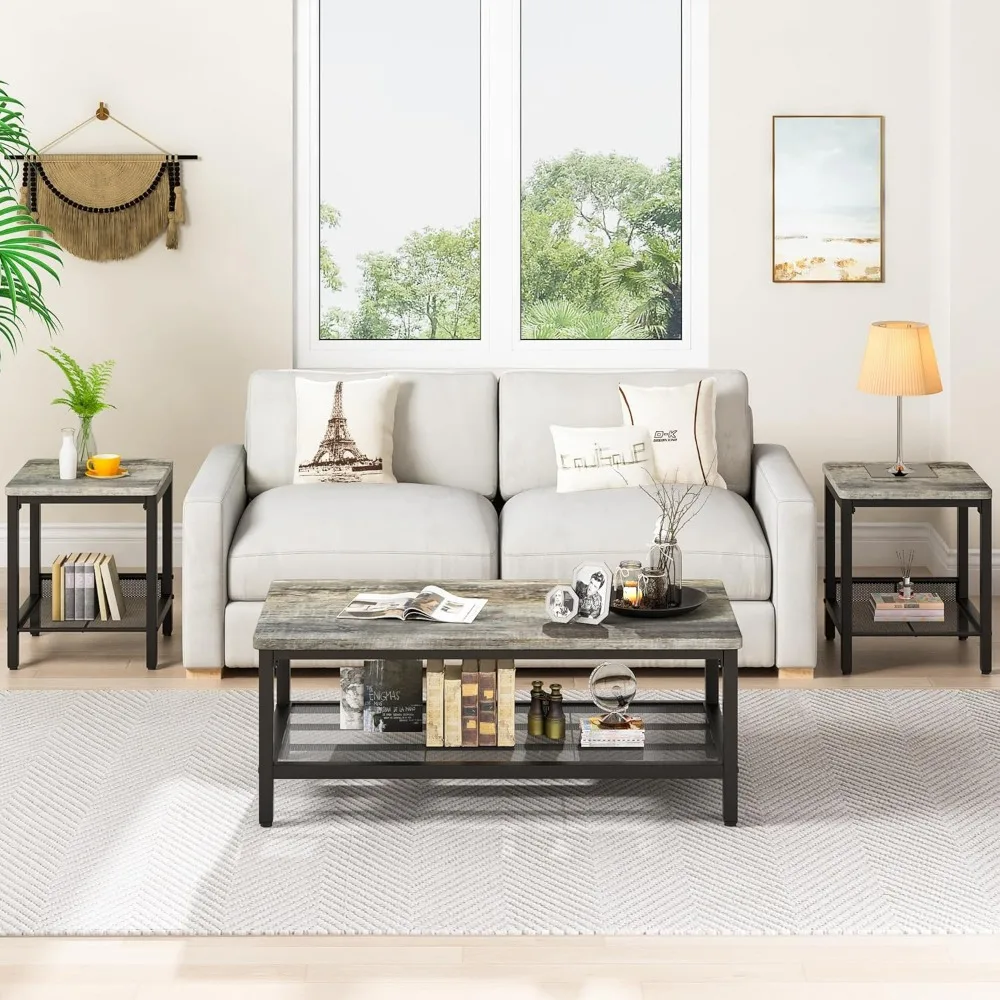
Small Space Solutions: Making It Work in Compact Rooms
Limited square footage doesn’t mean sacrificing style or functionality. With smart choices, even compact spaces can accommodate comfortable seating around a square coffee table.
For small living areas:
– Choose a smaller square coffee table (24-30 inches/61-76 cm) that maintains proper clearance
– Opt for armless chairs or loveseats instead of full-sized sofas with bulky arms
– Consider multifunctional pieces like storage ottomans that can serve as extra seating
– Look for furniture with exposed legs to create visual space underneath
– Select glass or acrylic tables that reduce visual weight
Nesting table sets offer particular advantages in small spaces. These versatile pieces can be expanded when you have guests and tucked away when you need more floor space, providing the perfect compromise between surface area and room to move.
Remember that in smaller rooms, every inch counts—reducing the coffee table-to-seating clearance to 14 inches (35 cm) rather than 18 inches (45 cm) can make the difference between a cramped arrangement and one that breathes.
Large Room Strategies: Defining Zones with Your Arrangement
In spacious or open-concept living areas, furniture arrangement plays a crucial role in defining distinct functional zones. A square coffee table can serve as an effective anchor for these separate areas.
To create well-defined zones in larger spaces:
– Use area rugs to establish boundaries—the rug should extend 12-18 inches (30-45 cm) beyond the coffee table on all sides
– Consider creating multiple seating groups with separate coffee tables if the room is very large
– Position your main seating arrangement to face architectural features like fireplaces or views
– Use console tables or bookcases as room dividers that complement your coffee table style
The strong geometric presence of a square coffee table creates a clear focal point that helps establish zone boundaries. Experts who arrange rooms with large coffee tables often use this shape to create visual anchors that prevent the space from feeling cavernous or disorganized.
Working Around Architectural Features
Fireplaces, windows, columns, and other architectural elements can complicate furniture arrangement. Instead of fighting against these features, integrate them into your seating plan with your square coffee table as the mediating element.
For rooms with fireplaces:
– Position the coffee table centrally between the fireplace and primary seating
– For corner fireplaces, angle furniture to create a diamond arrangement with the square table
– Maintain equal distances between architectural features and furniture to create balance
For rooms with columns or structural posts:
– Use the square table to create symmetry around the structural element
– Position seating to incorporate the column into the arrangement rather than avoiding it
– Create clear pathways that navigate naturally around both the column and table
Understanding the advantages of square coffee tables helps you work with architectural features rather than against them. Their balanced proportions can restore symmetry to rooms with irregular features or create organized pathways in challenging layouts.
Complementary Elements: Completing Your Seating Arrangement
While your square coffee table and seating form the foundation of your living space, complementary elements bring the arrangement to life. These additional components enhance both functionality and aesthetic appeal, transforming a basic furniture grouping into a cohesive, inviting room. The right supporting pieces can make your seating arrangement more comfortable, convenient, and visually complete.
The Perfect Rug: Unifying Your Arrangement
An area rug anchors your seating group and defines the conversation area. With square coffee tables, rug selection becomes especially important as it reinforces or softens the geometric theme.
For optimal rug placement:
– Choose a rug large enough to accommodate all furniture in your seating group
– For standard arrangements, select a rug at least 8×10 feet (2.4×3 meters)
– Position all furniture legs on the rug for formal settings, or just front legs for casual rooms
– Allow 18-24 inches (45-61 cm) of rug to extend beyond furniture on all sides
When pairing rugs with square coffee tables, consider both reinforcing and contrasting shapes. A square or rectangular rug with a square table creates formal geometric harmony, while a round rug softens the arrangement and creates interesting visual tension between the shapes.
Integrating Side Tables: Convenience and Balance
Side tables complement your coffee table by providing additional surface space while balancing the visual weight of your seating arrangement.
For harmonious side table integration:
– Position side tables within easy reach of seating, typically 3-6 inches (7.6-15.2 cm) from the arm
– Maintain a height difference of 2-4 inches (5-10 cm) between side tables and your coffee table
– For visual cohesion, choose side tables that share elements with your coffee table (material, finish, or style)
– Avoid placing side tables too close to your coffee table—maintain at least 16 inches (40 cm) between them
Many homeowners find that coordinated coffee and end table sets create a more polished, intentional look while ensuring proportional relationships between the pieces.
Ottomans and Poufs: Versatile Seating Additions
Ottomans and poufs add flexibility to your seating arrangement, serving as additional seating, footrests, or even supplementary table space when needed.
To effectively incorporate these versatile pieces:
– Position ottomans 14-16 inches (35-40 cm) from your square coffee table when used as seating
– Choose shapes that complement your coffee table—round poufs soften the angular lines while square ottomans reinforce them
– For multipurpose use, select flat-topped ottomans sturdy enough to hold drinks with a tray
– Consider nesting smaller ottomans under console tables when not in use to conserve space
These flexible pieces are particularly valuable for accommodating extra guests or creating casual seating options that can be easily repositioned as needs change.
Styling Your Square Coffee Table: Function Meets Beauty
A well-styled coffee table completes your seating arrangement, adding personality while maintaining functionality. Square tables offer unique styling opportunities with their four equal quadrants and strong geometric presence.
For balanced yet interesting coffee table styling:
– Apply the designer’s “rule of three” by grouping objects in odd numbers
– Create visual triangles with objects of varying heights (tall, medium, short)
– Use trays to corral smaller items and create defined zones for different functions
– Leave at least 1/3 of the table surface clear for practical use
– Incorporate elements with personal meaning alongside decorative objects
Different styling approaches work for different square table sizes:
– For larger tables (36+ inches/91+ cm), create a central focal point with surrounding smaller groupings
– For medium tables, divide the surface into quadrants with one serving as negative space
– For smaller tables, choose one statement piece with 1-2 smaller accessories
Remember that coffee table styling should reflect how you actually use the table. Beautiful styling shouldn’t prevent you from putting down a drink or playing a board game if that’s how your family uses the space.
Common Mistakes to Avoid When Arranging Seating
Even with careful planning, certain arrangement pitfalls can compromise both the look and functionality of your living space. Avoiding these common errors will help ensure your square coffee table and seating create a harmonious, usable room.
The most frequent arrangement mistakes include:
- Placing furniture against walls by default, creating excessive empty space in the center
- Choosing a coffee table that’s disproportionately small or large for the seating
- Ignoring clearance requirements, resulting in bumped knees or awkward movements
- Creating arrangements that block natural traffic patterns through the room
- Positioning seating too far apart for comfortable conversation
- Cluttering the coffee table surface until it loses functionality
- Failing to provide adequate lighting for different seating positions
A particularly common error occurs when people attempt to fit oversized furniture into rooms that can’t accommodate proper clearances. This almost always results in uncomfortable, impractical arrangements that look awkward and feel cramped, regardless of the coffee table shape.
Your Perfect Arrangement: Where Form Meets Function
Creating the ideal seating arrangement around your square coffee table requires balancing aesthetic preferences with practical needs. The most successful living spaces honor both elements equally, resulting in rooms that look beautiful and function effortlessly.
The key principles to remember include maintaining proper proportions between your coffee table and seating (roughly two-thirds the length of your sofa), allowing adequate clearance for comfortable movement (14-18 inches/35-45 cm from table to seating), and creating conversation-friendly distances between seating pieces.
Square coffee tables offer unique advantages in furniture arrangement—their balanced proportions create natural symmetry, their corners define clear traffic patterns, and their shape complements both traditional and contemporary seating styles. By following the guidelines in this guide while adapting them to your specific space and needs, you’ll create a living area that feels intentional, inviting, and perfectly suited to your lifestyle.
At Hearth Forms, we understand that the right coffee table becomes the heart of your living space. Your arrangement should reflect not just design principles, but also how you live, entertain, and relax in your home.

